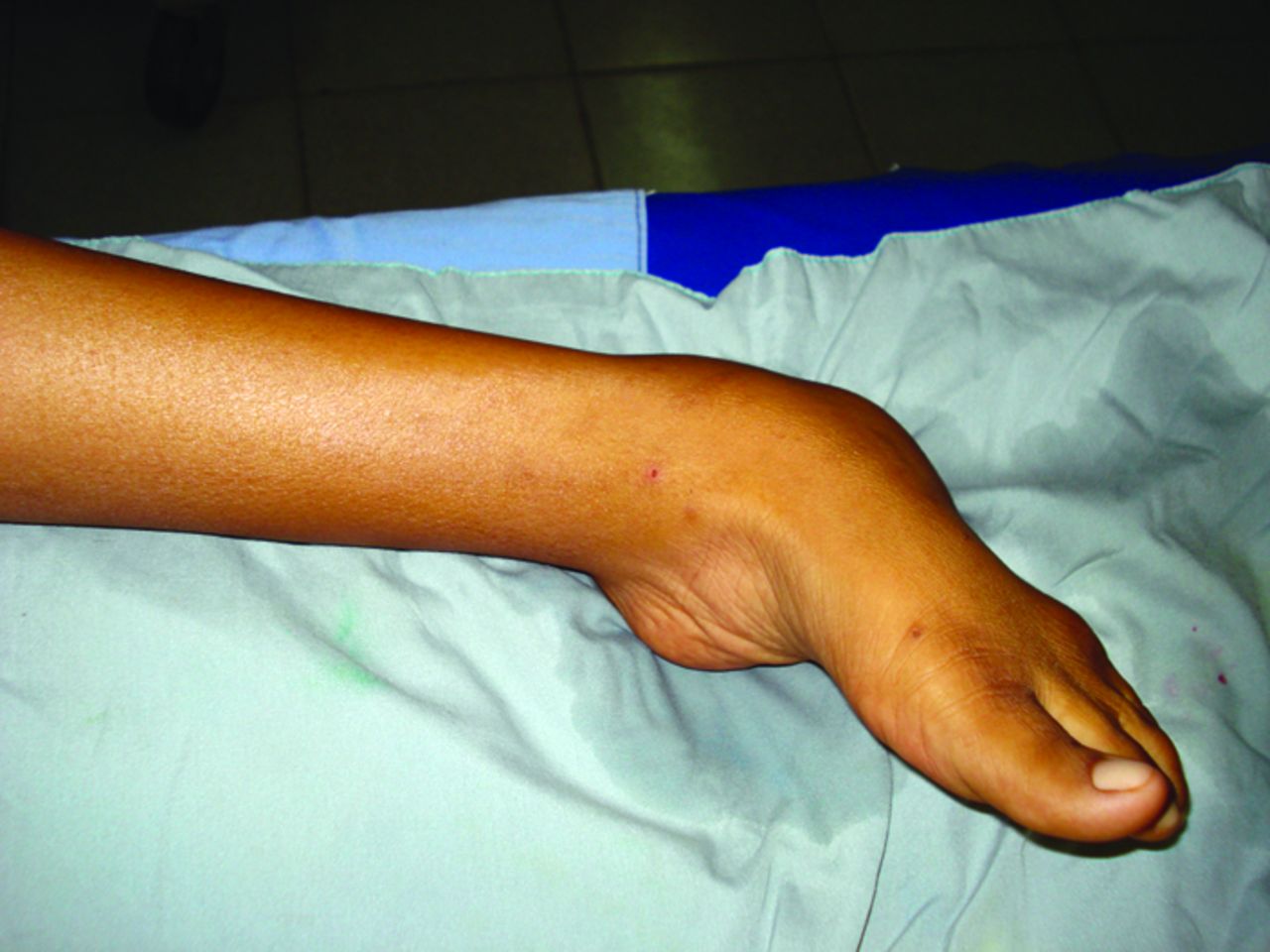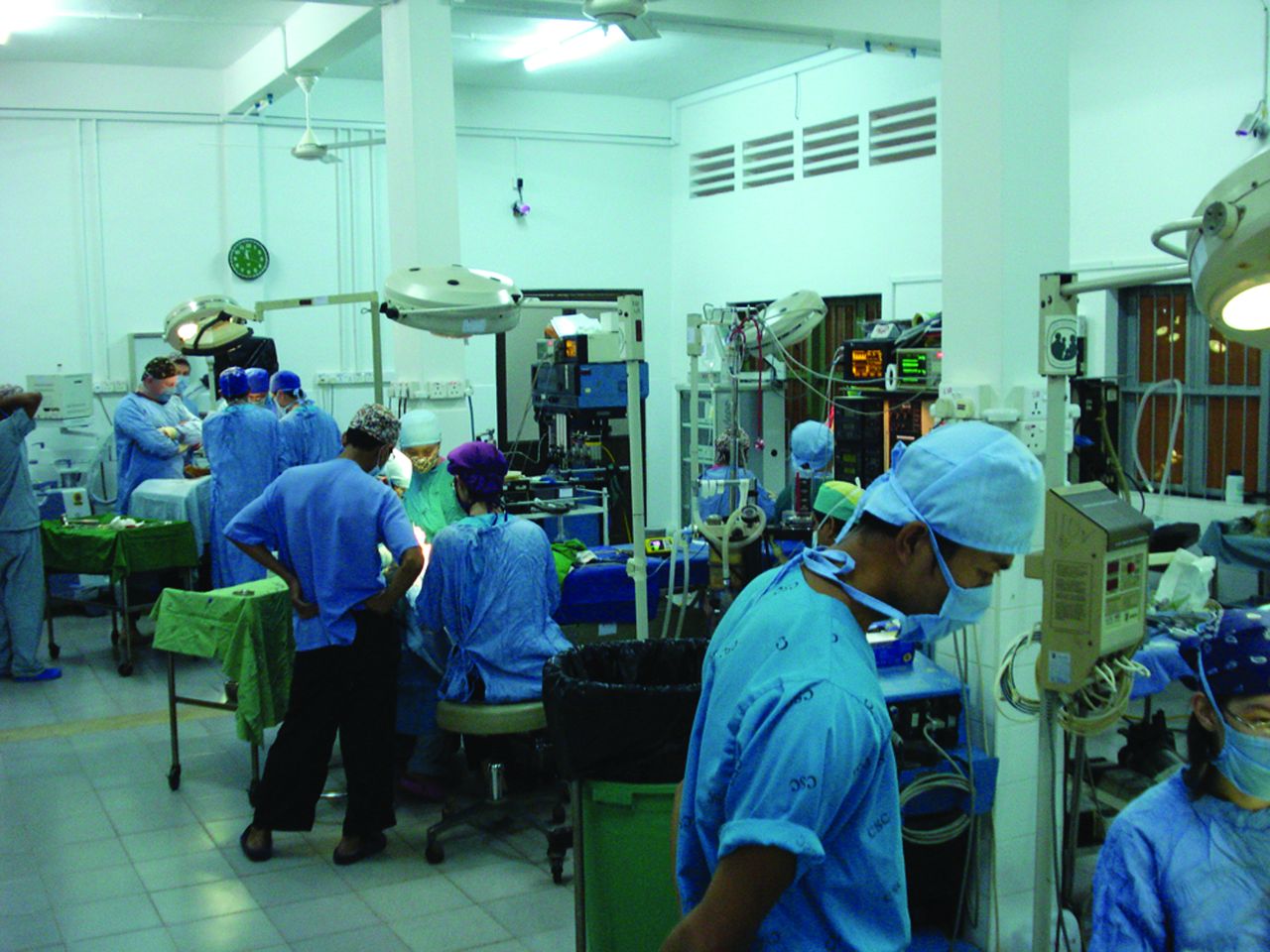It is estimated that 1.5 million Cambodians of a total population of eight million died of starvation, execution or disease between 1975 and1979. There has been a slow process of rebuilding and Phnom Penh now has a population of two million and is undergoing major and rapid redevelopment.
The Children’s Surgical Centre is a non-government organisation, established in 1998 by Dr Jim Gollogly, an orthopaedic surgeon with extensive experience of surgery in the developing world. The hospital provides care for the poor of Cambodia with an emphasis on children but also treats adult patients with a variety of conditions. The local population generates a spectrum of orthopaedic pathology, and the addition of national referrals for limb deformity, chronic trauma and infection equates to approximately 20 000 consultations and around 3000 surgical procedures annually.
The hospital offers predominantly reconstructive and rehabilitative services and has an orthopaedic/plastic surgery department staffed by three senior Khmer surgeons and two residents (SHOs). Specialist surgeons from UK, USA, Japan, France, Australia, Hong Kong, Canada and Singapore visit on a regular basis and provide surgical and educational support.
My personal involvement with this initiative began with a call from one of my trainees. He was spending a six-month period at the Children’s Surgical Centre and had come across several cases to which he felt I could contribute and so I arranged an initial visit in 2012. The administration associated with travel registration and indemnity was remarkably straightforward and it would probably be more difficult to organise a library card on home soil.
Working in an unfamiliar geographical and cultural environment is daunting and I mitigated this with a set of simple personal rules that were to remind me that:
- I am only as good as my last case;
- I must do nothing that would be clinically inappropriate in Bristol;
- I should err on the side of caution.
The first thing that struck me was the incredible volume of patients that sought an opinion. The calm and respectful manner in which they were prepared to wait, often for a considerable amount of time, was an introduction to culture shock. The equivalent circumstances in an English institution would result in wholesale grumpiness possibly and a mini riot.
Parents attended with their children to seek an opinion and were invariably prepared to accept this without discussion, negotiation or information on alternative approaches. Medicine in general, and orthopaedic surgery in particular, succeeds or fails according to the management of expectation and I initially interpreted the passive acquiescence as a deficiency in my ability to communicate through an interpreter. I rapidly learnt that this was largely due to a cultural difference and a very hierarchical approach to medical advice.
The working day in Phnom Penh typically began at 0800 with a clinical meeting and we generally worked until 1700 with a short break for lunch and the day punctuated with Coca Cola. The outpatient service was busy but the level of organisation involved in record keeping and retrieval was sophisticated, and plain radiology was readily available.
The case mix involved a variety of conditions that I was familiar with but were presenting late. This was due to a number of factors including lack of access to basic medical services and alternative, traditional healthcare arrangements that were often favoured by parents. Although somewhat limited in scope, the Children’s Surgical Centre offers high quality Western-standard health care, and the surgical inventory was sufficient to support the majority of orthopaedic surgical procedures including limb deformity correction using circular external fixators, hip arthroplasty and spinal surgery.
My remit, and the purpose of my visit, was to advise on the management of CTEV in adolescent patients who had not had any initial treatment. However, the first patient I saw with a significant foot deformity was the result of an encounter with a cobra, leading to extensive contractures.
My previous experience of working with snakes was confined to my tenure in hospital management but I was able to use general principles of deformity correction to provide a rational management plan. I was able to demonstrate details of pre-operative planning and use of external fixators in this circumstance to the Khmer surgeons. They rapidly absorbed the principles of circular frame surgery and included this in their surgical repertoire. The fine wire circular fixator was developed in a resource-poor environment and although a superficially complex method of treatment, it lends itself well to this environment (Figs 1 to 3).

Fig. 1
Severe, untreated talipes in a 15-year-old girl.

Fig. 2
The Illizarov external fixator for foot correction.

Fig. 3
Outcome at two years.
The hospital sees a large volume of paediatric injury, which is due to a mixture of urban motor vehicle accidents and rural and farming trauma. While the volume and variety can be intimidating, the application of standard principles of fracture care can be used to treat the vast majority of these patients. The initial management of these injuries was often by traditional methods of splintage and while this was usually adequate, it occasionally created additional problems including skin breakdown, infection, compartment syndrome and ischaemic contractures.
Undiagnosed/untreated osteoarticular infection, with bone loss and physeal injury, was commonly encountered and presented considerable management problems given the relatively modest resources of the country. A spectrum of techniques including external fixator correction, grafting and fibular transfer were in common use.
There were large numbers of patients with congenital limb abnormalities and the general advice was to improve function using a prosthetic rather than embarking on protracted, difficult surgery with an unpredictable but probably unsatisfactory outcome. There was excellent provision of lower limb prosthetics, with expertise derived from a long experience of discarded ordnance and the enthusiastic use of anti-personnel mines in recent conflict.
CSC is the only hospital in Cambodia that routinely accepts referrals for sarcomas and there was a depressing number of oncology cases, often presenting very late. Patients were beyond the stage where they could be effectively managed and there were often strongly held views that prevented discussion of palliative measures including ablative surgery. There was a great effort in place to provide a rationalised chemo/radiotherapy service, and the ambition of the centre is for this to mature in the coming years.
The operating room was well equipped and it was not uncommon for several teams to be working concurrently (Fig. 4). I had initial concerns about sterility, but it was very obvious that the procedures were robust and although this would be anathema in the ‘developed’ world, it provided every efficient method of running a high volume surgical service. The level of anaesthetic provision was first rate, using a combination of general and regional techniques with appropriate monitoring and processes including surgical checklists in evolution. The modest choice of surgical implants mandated careful pre-operative planning and made me return to the practical basis of surgery that had been displaced, in my brain at least, by a wide range of surgical toys. Any surgeon with a sound basis in the principles of operative management would be able to negotiate their way through the busy and often complex case mix.

Fig. 4
The surgical floor.
There are broad opportunities for research and development and the centre is host to international teams on a frequent basis. The timetable is geared to the specific expertise of the visitors and my initial visit was preceded by a team of plastic surgeons from France and was to be followed by an arthroplasty team from the United States.
The volume and complexity of work is appropriate for clinical research and there are frequent visiting elective medical students from a number of Western universities. We have begun an elective programme as part of the external eSSC component of undergraduate studies and our first student will arrive in summer 2014 with a pre-arranged research project involving a Khmer language functional scoring system.
During my visit, I communicated home via Skype and it became very clear to me, even as a rudimentary technology user, that this provided a potentially useful educational resource. We have since established a regular clinical conference between CSC and the Bristol Children’s Hospital in which we discuss cases and outcomes and include a general teaching component. This provides ongoing technical assistance to the Cambodian surgeons and presents a forum for the discussion of difficult cases. They are in the position to educate us about a pathology that we would not usually encounter and this facilitates the exchange of ideas and different technical approaches which often translate between the two centres. These conferences have become very popular and we routinely fill a lecture theatre with surgeons, nursing staff, physiotherapists and students.
We have also been able to encourage our trainees to spend six-month attachments at CSC, providing a unique training experience. I support this with weekly, hour-long, one-to-one mentorship conference calls. This allows case-based discussion and clinical evaluation exercises with direct observation of procedural skill and procedure-based assessments to be accommodated during visits to the CSC.
It has been a very great privilege to be involved in this project, albeit in a superficial (but I hope useful) way. I have made a commitment to continue with the educational and academic support and to visit on an annual basis. I have benefited enormously from the experience and I do hope that this has translated into some small benefit for the lot of these very dignified people.









